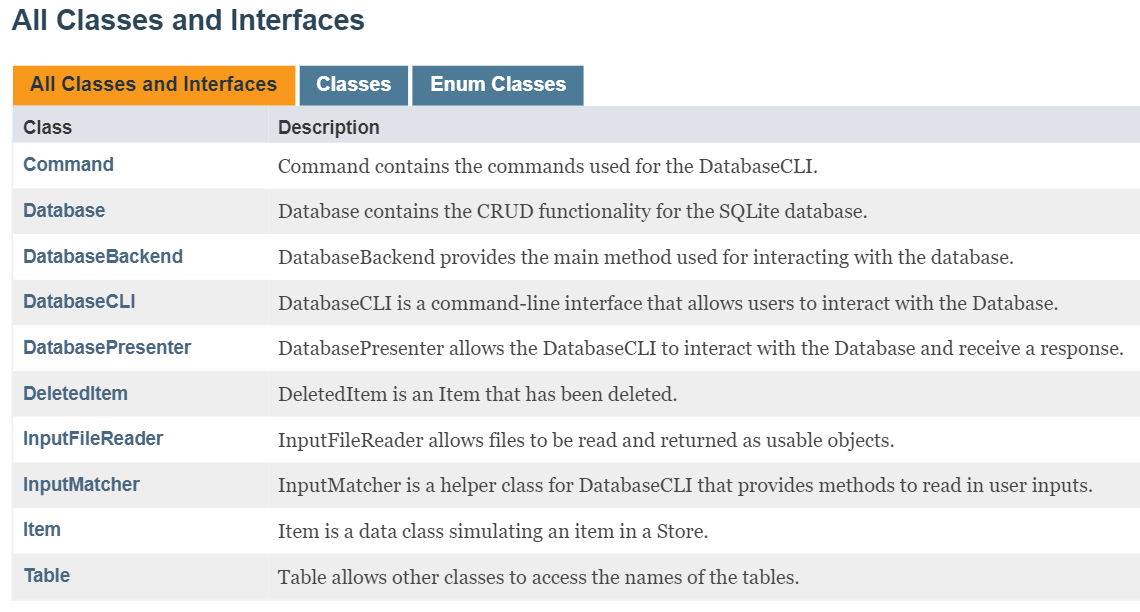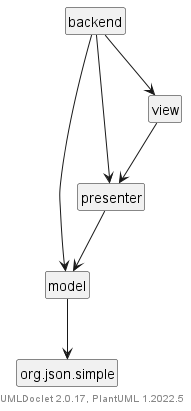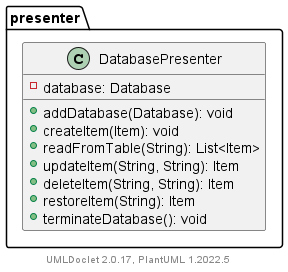A project for Shopify's Fall 2022 Backend Engineer Intern Challenge. This project involves independently creating a simple CRUD application. The additional requirement satisfied for the challenge is: When deleting, allow deletion comments and undeletion.
This application is prepared to run with an online IDE called Replit. See the Replit Instructions section for details.
Instructions on how to run the app from terminal are provided in General Instructions.
The badge above directs the user to the app on Replit. Once there, click the large green button. Various packages will be downloaded before the application begins.
See Application Commands for the available commands in the application. See Console Commands for commands to interact with the 'Console' tab on Replit.
The app requires at least JDK 17 and Maven 3.8.x to run. Graphviz must also be installed for a plugin this app uses. Once those are installed, the app can be run manually by executing the two commands below in a terminal navigated to the project's folder. To navigate in terminal to the project's folder, obtain the full file path to the project folder, and enter cd filePathToProjectFolder in terminal. Click here for more information about what cd is. For more details about the commands see Maven Commands).
mvn clean install
mvn compile exec:java
These commands can be used while the application is running. They are case-insensitive. The square brackets should be omitted.
-
CREATE [name] [dollar.cents] [stock]- insert a row into the tableitems. The attributenamemust be one word with alphanumeric characters -
READ [tableName]- view the rows from one of the following tables:items,deleted_items -
UPDATE [id] [columnName] = [value]- update a value corresponding to a column name in the table items. Text values must be quoted like 'this' (ex:update name = 'GreenFresh') -
DELETE [id] [optionalComment]- delete a row in the tableitemswhile providing an optional comment -
RESTORE [id]- restores a row with the provided id to its corresponding table -
HELP- view the list of valid commands -
TABLES- view the list of tables -
QUIT- exit the application
Note that the UPDATE command is limited to updating one value on one item at a time.
These commands interact with the application itself. They can be run on any operating system from the terminal navigated to the project folder. On Replit, the console is already in the project folder and the first two commands below are done automatically with the green 'run' button.
mvn clean install- download the packages for the app to Replitmvn compile exec:java- execute the applicationmvn test- run the app's unit tests
These commands are meant for the Replit 'Console' tab configured for Linux. Note that file refers to java, javac, or mvn.
Ctrl+C(keyboard) - cancel a process in actionkill 1- type in the 'Shell' while a process is running in 'Console' to cancel it and restart the application[file] -version- check the version of a file, without the bracketscommand -v [file]- check the filepath of a file, without the brackets
This application simulates an online store manager. It lacks integration as a web application as it does not use an online server. My experience with less strict languages like JavaScript and Python is limited to scripting. I chose to simulate a web application using a Java command-line interface. For the database, I used SQLite for its ability to be embedded within the application.
The architectural design pattern used for the GUI is Model-View-Presenter. This separates responsibilities for different functions among different classes.
See Classes for more details on how the application is designed. See Tests for descriptions of the unit tests performed. See Technologies for some plugins used.
Show Design Details
The method to run this application is found in the file DatabaseBackend. It begins a loop that prompts the user for input in the form of a Command and displays an appropriate output. This loop continues until the user enters QUIT.
The tables for this project are items and deleted_items. Both contain Items, which each have an id, name, price, and stock. Id is specified by the SQL database. DeletedItem, a subclass of Item, may contain an optional comment.
When an Item is deleted from a table using the DELETE Command, it is inserted into the deleted_items table. The RESTORE Command deletes the item from the deleted_items table, returning the DeletedItem to its original table as an item.
Commands are processed by pattern-matching and group capturing with Regex. The captured input groups are passed and formatted for the SQL database before being executed. The Regex group capturing limits the application to whatever is hard-coded. It favors security by disallowing input that doesn't match the required format.
Class descriptions and UML class diagrams are provided for an overview of the system. They were generated using the UMLDoclet plugin (more details under Technologies).
All classes and almost all methods are fully documented. Below are the class descriptions.

This diagram illustrates the relationship between the application's packages. The packages for the project are divided amongst the view, presenter, and model per the Model-View-Presenter pattern. backend contains the main method. org.json.simple is a dependency.

Show Class Diagrams
The model package contains the main Model class, Database. It also contains the Item classes, an enumeration for the names of the SQL tables (accessed by all packages), and InputFileReader to read files used for initializing the Database and testing.

The presenter package only contains the main Presenter class, DatabasePresenter. In hindsight, DatabasePresenter could have contained methods to format input Strings for the View and returned Strings instead of returning Items.

The view package contains the main View class, DatabaseCLI, as well as a Command enumeration and InputMatcher helper class.

Backend creates the Database, DatabasePresenter, and DatabaseCLI before beginning the input loop.

DDL.sql- contains the SQL statements used to define the database schemaitems.json- contains the information used to populate the tableitemstestUserInputs.json- contains valid and invalid inputs that a user might enter. Used for testing withCommandTest(see below)
Rigorous unit testing was used throughout development to verify application functions. Below are descriptions of the test files.
DatabaseTestensures the Database's CRUD methods work properlyDatabasePresenterTestensures the DatabasePresenter's CRUD methods work properly with the DatabaseDatabaseCLITestensures that DatabaseCLI's CRUD methods work properly with the DatabasePresenterCommandTestensures that Command's search method work properly with the inputs found intestUserInputs.jsonItemTestensures that Item's price conversion methods work properlyInputFileReaderTestensures that inputs files are read properly
As this project is managed with Maven, the plugins and dependencies used are contained in the file pom.xml. Alternatively, an up-to-date list of dependencies can be found on GitHub. However, it does not include plugins.
If the user is running the application with the General Instructions, full API documentation including UML class diagrams can be generated using UMLDoclet. UMLDoclet is not included in the Replit.
To use UMLDoclet, Graphviz must be installed. To activate it, run mvn install in terminal. The documents generated are located in the folder target/apidocs.
- SQLite - a relational database that is self-contained, meaning it does not require as much client-server configuration as MySQL or PostgreSQL
- JSONSimple - JSON file manipulation
- UMLDoclet - generates interactive Javadoc pages and UML Class Diagrams for packages. It is executed when the user runs
mvn install
Overall, I am satisfied with this project. It would be interesting to do a similar application with more frontend technologies.
The reader should note that this project demonstrates the following:
- Thorough technical and user documentation
- Written communication skills
- Emphasis on unit testing to verify application functions
- Knowledge of SQL
- Application of design patterns (specifically, Model-View-Presenter)
- Error detection and handling
- Coding and development style
- Knowledge of GitHub and Markdown